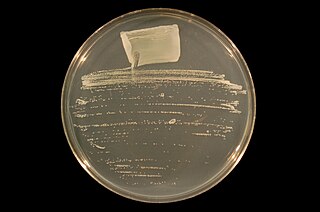The halophiles, named after the Greek word for "salt-loving", are extremophiles that thrive in high salt concentrations. While most halophiles are classified into the domain Archaea, there are also bacterial halophiles and some eukaryotic species, such as the alga Dunaliella salina and fungus Wallemia ichthyophaga. Some well-known species give off a red color from carotenoid compounds, notably bacteriorhodopsin. Halophiles can be found in water bodies with salt concentration more than five times greater than that of the ocean, such as the Great Salt Lake in Utah, Owens Lake in California, the Urmia Lake in Iran, the Dead Sea, and in evaporation ponds. They are theorized to be a possible analogues for modeling extremophiles that might live in the salty subsurface water ocean of Jupiter's Europa and similar moons.

Acidobacteriota is a phylum of Gram-negative bacteria. Its members are physiologically diverse and ubiquitous, especially in soils, but are under-represented in culture.

Thermus is a genus of thermophilic bacteria. It is one of several bacteria belonging to the Deinococcota phylum. Thermus species can be distinguished from other genera in the family Thermaceae as well as all other bacteria by the presence of eight conserved signature indels (CSIs) found in proteins such as adenylate kinase and replicative DNA helicase as well as 14 conserved signature proteins (CSPs) that are exclusively shared by members of this genus.

Halomonadaceae is a family of halophilic Pseudomonadota.

Ensifer is a genus of nitrogen-fixing bacteria (rhizobia), three of which have been sequenced.
In taxonomy, Haloferax is a genus of the Haloferacaceae.
In taxonomy, Natrialba is a genus of the Natrialbaceae. The genus consists of many diverse species that can survive extreme environmental niches, especially they are capable to live in the waters saturated or nearly saturated with salt (halophiles). They have certain adaptations to live within their salty environments. For example, their cellular machinery is adapted to high salt concentrations by having charged amino acids on their surfaces, allowing the cell to keep its water molecules around these components. The osmotic pressure and these amino acids help to control the amount of salt within the cell.
Thermoanaerobacter is a genus in the phylum Bacillota (Bacteria). Members of this genus are thermophilic and anaerobic, several of them were previously described as Clostridium species and members of the now obsolete genera Acetogenium and Thermobacteroides

Haloferax volcanii is a species of organism in the genus Haloferax in the Archaea.
Virgibacillus is a genus of Gram-positive, rod-shaped (bacillus) bacteria and a member of the phylum Bacillota. Virgibacillus species can be obligate aerobes, or facultative anaerobes and catalase enzyme positive. Under stressful environmental conditions, the bacteria can produce oval or ellipsoidal endospores in terminal, or sometimes subterminal, swollen sporangia. The genus was recently reclassified from the genus Bacillus in 1998 following an analysis of the species V. pantothenticus. Subsequently, a number of new species have been discovered or reclassified as Virgibacillus species.
The Natranaerobiales are an order of bacteria placed within the class Clostridia. This order contains the thermophilic bacterial species Natranaerobius thermophilus and the related species Natranaerobaculum magadiense.
Haloferax larsenii is a gram-negative, aerobic, neutrophilic, extremely halophilic archaeon. It was named in honor of Professor Helge Larsen, who pioneered research on halophiles.
Azospirillum is a Gram-negative, microaerophilic, non-fermentative and nitrogen-fixing bacterial genus from the family of Rhodospirillaceae. Azospirillum bacteria can promote plant growth.
Haloferacaceae is a family of halophilic, chemoorganotrophic or heterotrophic archaea within the order Haloferacales. The type genus of this family is Haloferax. Its biochemical characteristics are the same as the order Haloferacales.
Haloferax sulfurifontis is a species of archaea in the family Haloferacaceae.
Haloferax alexandrinus is a species of archaea in the family Haloferacaceae.
Haloferax mediterranei is a species of archaea in the family Haloferacaceae.
Haloferax mucosum is a species of archaea in the family Haloferacaceae.
Haloferax prahovense is a species of archaea in the family Haloferacaceae.
Haloferacales is an order of halophilic, chemoorganotrophic or heterotrophic archaea within the class Haloarchaea. The type genus of this order is Haloferax.




